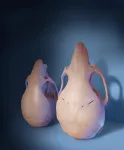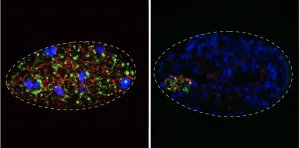Stem cell therapy corrects skull, brain function in mouse model of childhood disorder
Scientists regenerate parts of the skull affected by craniosynostosis, a common birth defect
2021-01-07
(Press-News.org) Using stem cells to regenerate parts of the skull, scientists corrected skull shape and reversed learning and memory deficits in young mice with craniosynostosis, a condition estimated to affect 1 in every 2,500 infants born in the United States, according to the Centers for Disease Control and Prevention. The only current therapy is complex surgery within the first year of life, but skull defects often return afterward. The study, supported by the National Institute of Dental and Craniofacial Research (NIDCR), could pave the way for more effective and less invasive therapies for children with craniosynostosis. The findings were published Jan. 7, 2021 in Cell. NIDCR is part of the National Institutes of Health.
"This is a pivotal study demonstrating both structural regeneration and functional restoration in an animal model of craniosynostosis, said Lillian Shum, Ph.D., director of NIDCR's Division of Extramural Research. "It holds great potential for translation to treatment of the human condition."
Healthy infants are born with sutures--flexible tissue that fills the space between the skull bones--that allow the skull to expand as the brain grows rapidly in the first few years of life. In craniosynostosis, one or more sutures turn into bone too early, closing the gap between skull plates and leading to abnormal growth. The resulting increase in pressure inside the skull may cause physical changes in the brain that lead to thinking and learning problems.
"The connection between changes in the skull and the development of cognitive deficits had not been fully explored," said Yang Chai, D.D.S., Ph.D., director of the Center for Craniofacial Molecular Biology and associate dean of research at the Herman Ostrow School of Dentistry at the University of Southern California, Los Angeles, who led the study. "We wanted to know if restoring sutures could improve neurocognitive function in mice with mutations in a gene that causes craniosynostosis in both mice and humans."
That gene, called TWIST1, is thought to be important for suture formation during development. In humans, mutations in this gene can lead to Saethre-Chotzen syndrome, a genetic condition characterized by craniosynostosis and other skeletal abnormalities.
To see if flexible sutures could be restored in mice with craniosynostosis due to Twist1 mutations, the scientists focused on a group of stem cells normally found in healthy sutures. Previous studies by the group indicated that these stem cells--called Gli1+ cells--are key to keeping skull sutures of young mice intact. The team had also found that Gli1+ cells are depleted from the sutures of mice that develop craniosynostosis due to Twist1 mutations. Chai and his colleagues reasoned that replenishing the cells might help regenerate the flexible sutures in affected animals.
To test this idea, the researchers added Gli1+ cells from healthy mice to a biodegradable gel. They deposited the mixture into grooves meant to re-create the space where skull sutures had been in mice with craniosynostosis.
Skull imaging and tissue analysis revealed that after six months, new fibrous sutures had formed in treated areas and that the new tissue remained intact even after a year. In contrast, the same grooves closed in mice that received a gel that lacked Gli1+ cells.
Closer analysis showed that Gli1+ cells in the regrown sutures had different origins: some were descended from the cells that had been implanted, while others were the animals' own, having migrated from nearby areas. The findings suggest that Gli1+ cell implantation leads to suture regeneration in part by recruiting native Gli1+ stem cells to help in the process.
Further experiments showed that untreated mice with craniosynostosis had increased pressure inside their skulls and poor performance on tests of social and spatial memory and motor learning. After treatment, these measures all returned to levels typical of healthy mice. The skull shapes of treated mice were also partially corrected.
The treatment also reversed the loss of brain volume and nerve cells in areas involved in learning and memory. According to the scientists, this finding sheds light on the mechanisms underlying impaired brain function and its improvement after suture regeneration.
"We have discovered that Gli1+ stem-cell-based suture regeneration restores not only skull shape but also neurocognitive functions in a mouse model of craniosynostosis," said Chai.
The scientists note that more work remains before such an intervention can be tested in humans, including studies to determine the optimal timing of surgery and the ideal source and amount of stem cells.
"This study provides a foundation for efforts to develop a less-invasive, stem cell-based therapeutic strategy that can benefit patients who suffer from this devastating disorder," Chai said.
INFORMATION:
Article: Yu, M. et al. Cranial suture regeneration mitigates skull and neurocognitive defects in craniosynostosis. Cell. Jan. 7, 2021. DOI: 10.1016/j.cell.2020.11.037
This research was supported by NIDCR grants R01-DE026339, R01-DE012711, R01-DE022503, and U24-DE026914.
About the National Institute of Dental and Craniofacial Research: NIDCR is the nation's leading funder of research on oral, dental, and craniofacial health.
About the National Institutes of Health: NIH, the nation's medical research agency, includes 27 Institutes and Centers and is a component of the U.S. Department of Health and Human Services. NIH is the primary federal agency conducting and supporting basic, clinical, and translational medical research, and is investigating the causes, treatments, and cures for both common and rare diseases.
[Attachments] See images for this press release:

ELSE PRESS RELEASES FROM THIS DATE:
2021-01-07
Humans feeding leftover lean meat to wolves during harsh winters may have had a role in the early domestication of dogs, towards the end of the last ice age (14,000 to 29,000 years ago), according to a study published in Scientific Reports.
Maria Lahtinen and colleagues used simple energy content calculations to estimate how much energy would have been left over by humans from the meat of species they may have hunted 14,000 to 29,000 years that were also typical wolf prey species, such as horses, moose and deer. The authors hypothesized that if wolves and humans had hunted the same animals during harsh winters, humans would have killed wolves to reduce competition rather than domesticate them. With the exception of Mustelids such as weasels, ...
2021-01-07
"Nature red in tooth and claw" - The battle to survive is fought down to the level of our genes. Toxin-antidote elements are gene pairs that spread in populations by killing non-carriers. Now, research by the Burga lab at IMBA and the Kruglyak lab at the University of California, Los Angeles shows that these elements are more common in nature than first thought and have evolved a wide range of mechanisms to force their inheritance and propagate in populations - a parasite within the genome.
Originally described in the model nematode Caenorhabditis elegans, toxin-antidote elements consist of two linked genes, a toxin and its antidote. While the toxin is loaded into eggs by mothers, only embryos that inherit the element express the antidote. Thus, the ...
2021-01-07
The National Human Genome Research Institute (NHGRI) within the National Institutes of Health (NIH) has released a new action agenda for a diverse genomics workforce. This ambitious set of goals, objectives, and implementation strategies details NHGRI's plans for enhancing the diversity of the genomics workforce by 2030.
"To reach its full potential, the field of genomics requires a workforce that better reflects the diversity of the U.S. population," NHGRI Director Eric Green, M.D., Ph.D., said. "Fostering an appropriately diverse genomics workforce of the future requires an immediate and substantial commitment ...
2021-01-07
Noncognitive skills and cognitive abilities are both important contributors to educational attainment -- the number of years of formal schooling that a person completes -- and lead to success across the life course, according to a new study from an international team led by researchers at Columbia University Mailman School of Public Health, the University of Texas at Austin, and Vrije Universiteit Amsterdam. The research provides evidence for the idea that inheriting genes that affect things other than cognitive ability are important for understanding differences in people's life outcomes. Until now there had been questions about what these noncognitive skills are and how much they really matter for life outcomes. The new findings are published ...
2021-01-07
What The Study Did: Under a range of assumptions of presymptomatic transmission and transmission from individuals with infection who never develop symptoms, the model presented here estimated that more than half of transmission comes from asymptomatic individuals.
Author: Jay C. Butler, M.D., of the U.S. Centers for Disease Control and Prevention in Atlanta, is the corresponding author.
To access the embargoed study: Visit our For The Media website at this link https://media.jamanetwork.com/
(doi:10.1001/jamanetworkopen.2020.35057)
Editor's Note: The article includes funding/support disclosures. Please see the article for additional information, including other authors, author contributions and affiliations, conflict of interest and ...
2021-01-07
What The Study Did: Population data from Denmark were used to examine whether age at exposure to negative experiences in childhood and adolescence (parents' unemployment, incarceration, mental disorders, death and divorce, and the child's foster care experiences) was associated with outcomes in early adulthood.
Author: Signe Hald Andersen, Ph.D., of the Rockwool Foundation Research Unit in Copenhagen, Denmark, is the corresponding author.
To access the embargoed study: Visit our For The Media website at this link https://media.jamanetwork.com/
(doi:10.1001/jamanetworkopen.2020.32769)
Editor's Note: The article includes funding/support disclosures. Please see the article for additional information, including other authors, author contributions and affiliations, ...
2021-01-07
What The Study Did: To adapt to broader public health initiatives around COVID-19, researchers developed a drive-through intraocular pressure (IOP) screening clinic to minimize COVID-19 exposure for patients and clinicians by measuring eye pressure in the unconventional setting of a clinic parking lot.
Authors: Miel Sundararajan, M.D., of the University of California, San Francisco, is the corresponding author.
To access the embargoed study: Visit our For The Media website at this link https://media.jamanetwork.com/
(doi:10.1001/jamaophthalmol.2020.6073)
Editor's Note: The article includes conflict of interest and funding/support disclosures. Please see the article ...
2021-01-07
What The Study Did: Researchers compared changes in preoperative aided speech recognition with postoperative speech recognition among individuals who received cochlear implants.
Authors: Theodore R. McRackan, M.D., M.S.C.R., of the Medical University of South Carolina in Charleston, is the corresponding author.
To access the embargoed study: Visit our For The Media website at this link https://media.jamanetwork.com/
(doi:10.1001/jamaoto.2020.5094)
Editor's Note: The article includes conflicts of interest and funding/support disclosures. Please ...
2021-01-07
What The Study Did: The outcomes of a cancer center-wide virtual care program launched in response to the COVID-19 pandemic were examined in this study.
Authors: Alejandro Berlin, M.D., M.Sc., of the Princess Margaret Cancer Centre in Toronto, Ontario, Canada, is the corresponding author.
To access the embargoed study: Visit our For The Media website at this link https://media.jamanetwork.com/
(doi:10.1001/jamaoncol.2020.6982)
Editor's Note: The article includes conflict of interest and funding/support disclosures. Please see the article for additional information, including other authors, author contributions and affiliations, conflict ...
2021-01-07
What The Study Did:This cross-sectional study maps a coronavirus research question to illustrate the overlap and shortcomings of the evidence syntheses in this area.
Author: Giordano Pérez-Gaxiola, M.D., M.Sc., of Sinaloa Pediatric Hospital's Cochrane Associate Centre in Culiacan, Mexico, is the corresponding author.
To access the embargoed study: Visit our For The Media website at this link https://media.jamanetwork.com/
(doi:10.1001/jamanetworkopen.2020.32769)
Editor's Note: Please see the article for additional information, including other authors, author contributions and affiliations, conflict of interest and financial disclosures, and funding and support.
INFORMATION:
Media advisory: ...
LAST 30 PRESS RELEASES:
[Press-News.org] Stem cell therapy corrects skull, brain function in mouse model of childhood disorder
Scientists regenerate parts of the skull affected by craniosynostosis, a common birth defect

